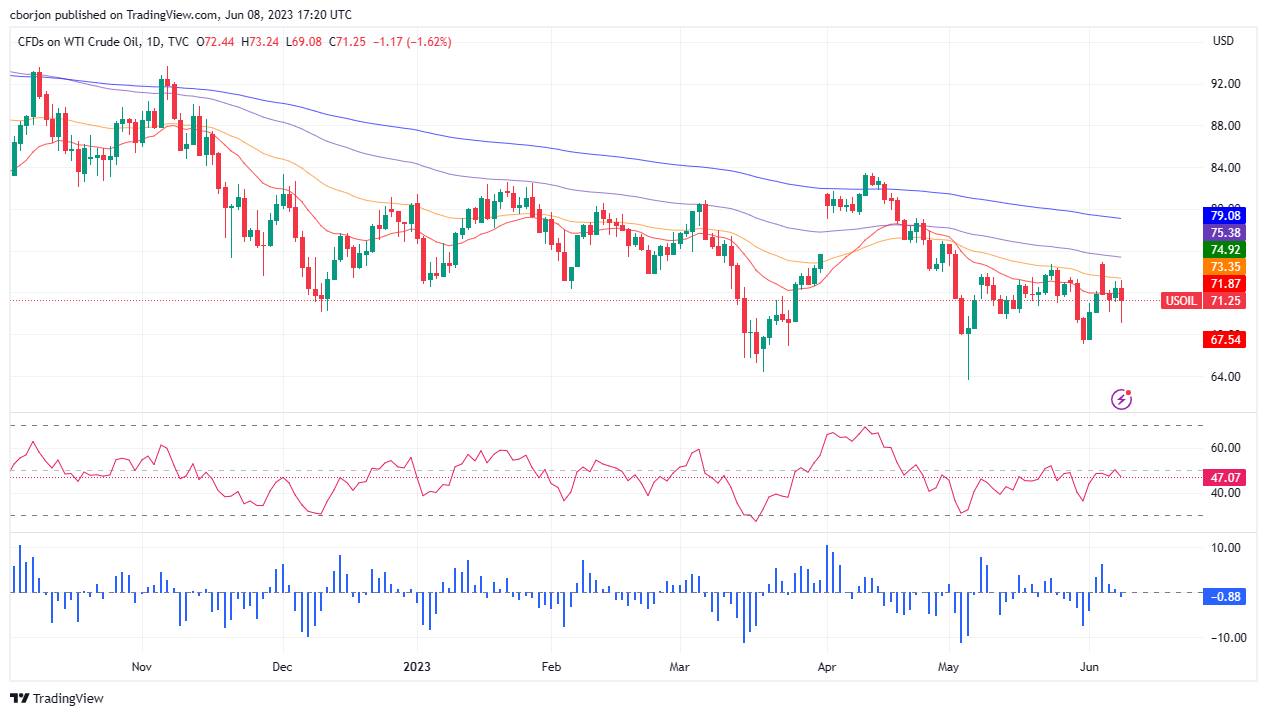- Unconfirmed US-Iran deal may unlock Iranian oil exports, pressure WTI prices.
- Saudi Arabia’s crude oil output cut of 1M bpd softens WTI’s decline.
- US Dollar weakness caps WTI’s fall as jobs report spurs rate hike uncertainty.
Western Texas Intermediate (WTI), the US crude oil benchmark, dropped sharply during Thursday’s North American session, courtesy of an “unconfirmed” report that the United States (US) and Iran may be near a temporary nuclear deal, which could unblock sanctions imposed by the US on Iran oil exports. WTI is trading at $70.38, below its opening price by 2.82%.
US crude benchmark plunges amidst rumors of potential Iran sanctions relief
According to Reuters, “Oil fell on a news report, citing sources, that Iran and the US are nearing a temporary deal that would trade some sanctions relief in exchange for reducing Iran’s uranium enrichment.”
If Iran agrees to reduce its uranium-enriched development, it could export up to a million barrels of oil daily and access frozen funds abroad.
WTI’s fall was cushioned by over-the-weekend developments with the Organization of Petroleum Exporting Countries and its allies (OPEC+) meeting on Sunday, with Saudi Arabia agreeing to cut its crude oil output by 1 million barrels per day (bpd) in July, as the cartel tries to boost oil prices.
Another factor that capped WTI’s fall was stockpiles in the US dropped last week by 451K barrels on June 2, as reported by the US Energy Information Administration (EIA). The markets expected a rise of 1M barrels per day.
Notably, the greenback posted several losses after a labor market report indicated that unemployment claims in the United States (US) rose above estimates. After the data, the consensus amongst investors that the US Federal Reserve (Fed) will skip increasing rates at the June meeting weakened the US Dollar. The US Dollar Index (DXY) is down 0.67%, at 103.347.
WTI Price Analysis: Technical outlook
WTI remains neutral to downward bias, yet still below the 20-day Exponential Moving Average (EMA), the first resistance at $71.86. Oil will continue its downtrend past that area and can challenge 2023 year-to-date (YTD) low of $63.61 if sellers claim the May 31 low of $67.08. It should be said that oscillators justify further downside, but if WTI breaks above the 20-day EMA and clears the 50-day EMA at $73.3s5, that could pave the way for further gains.
Information on these pages contains forward-looking statements that involve risks and uncertainties. Markets and instruments profiled on this page are for informational purposes only and should not in any way come across as a recommendation to buy or sell in these assets. You should do your own thorough research before making any investment decisions. FXStreet does not in any way guarantee that this information is free from mistakes, errors, or material misstatements. It also does not guarantee that this information is of a timely nature. Investing in Open Markets involves a great deal of risk, including the loss of all or a portion of your investment, as well as emotional distress. All risks, losses and costs associated with investing, including total loss of principal, are your responsibility. The views and opinions expressed in this article are those of the authors and do not necessarily reflect the official policy or position of FXStreet nor its advertisers. The author will not be held responsible for information that is found at the end of links posted on this page.
If not otherwise explicitly mentioned in the body of the article, at the time of writing, the author has no position in any stock mentioned in this article and no business relationship with any company mentioned. The author has not received compensation for writing this article, other than from FXStreet.
FXStreet and the author do not provide personalized recommendations. The author makes no representations as to the accuracy, completeness, or suitability of this information. FXStreet and the author will not be liable for any errors, omissions or any losses, injuries or damages arising from this information and its display or use. Errors and omissions excepted.
The author and FXStreet are not registered investment advisors and nothing in this article is intended to be investment advice.
Recommended content
Editors’ Picks
AUD/USD remains firm above 0.6600 ahead of RBA

AUD/USD maintains its bullish bias well and sound on Monday, extending the multi-session recovery past the 0.6600 barrier ahead of the key interest rate decision by the RBA.
EUR/USD keeps the constructive tone near 1.0800

EUR/USD started the week in a positive note amidst the Dollar’s inconclusive price action, altogether motivating the pair to attempt a move to the proximity of the 1.0800 region, where the 200-day SMA also converges.
Gold holds on to modest gains around $2,320

Gold trades decisively higher on the day above $2,320 in the American session. Retreating US Treasury bond yields after weaker-than-expected US employment data and escalating geopolitical tensions help XAU/USD stretch higher.
Bitcoin price holds above $63K as MicroStrategy tops BTC ownership list

Bitcoin (BTC) price recorded a rather bold two days this past weekend in a surge that saw millions in positions liquidated. However, the week is off to a calm start with altcoins sucking liquidity from the BTC market.
Stagflation warning: Service economy contracts as prices rise

In another stagflation warning sign, the U.S. service sector contracted in April even as service prices rose. The Institute for Supply Management's non-manufacturing PMI dropped to 49.4 in April, dipping from 51.4 in March.
